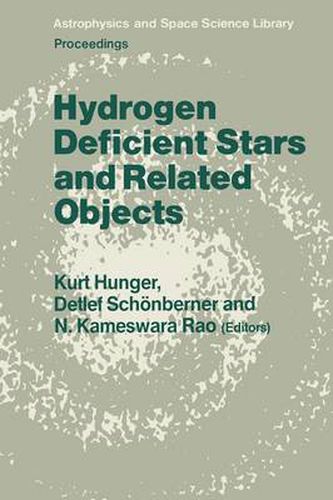Readings Newsletter
Become a Readings Member to make your shopping experience even easier.
Sign in or sign up for free!
You’re not far away from qualifying for FREE standard shipping within Australia
You’ve qualified for FREE standard shipping within Australia
The cart is loading…






This title is printed to order. This book may have been self-published. If so, we cannot guarantee the quality of the content. In the main most books will have gone through the editing process however some may not. We therefore suggest that you be aware of this before ordering this book. If in doubt check either the author or publisher’s details as we are unable to accept any returns unless they are faulty. Please contact us if you have any questions.
The first helium star was discovered in 1942, the first scientific meeting on the subject, however, took place in 1985. The meeting was hence long overdue for, in the meantime, a substantial amount of material had been accumulated by a rather small, but active scientific community. Hence, it appeared necessary to review the field in order to define the subject, assess its present status and discuss future developments. Hydrogen deficiency is a widespread phenomenon, occurring in a large variety of stellar and nonstellar objects. It can be readily detected in B stars as these exhibit both hydrogen and helium lines, if the elements are present in appreciable amounts. It becomes less manifest in cool stars, where the temperature is too low to excite helium and where one has to devise indirect methods for proving hydrogen deficiency. Clearly, it was not possible to discuss the whole complex of hydrogen deficiency, i.e. in both stars and diffuse matter, but rather to concentrate on the issue of helium stars.
$9.00 standard shipping within Australia
FREE standard shipping within Australia for orders over $100.00
Express & International shipping calculated at checkout
This title is printed to order. This book may have been self-published. If so, we cannot guarantee the quality of the content. In the main most books will have gone through the editing process however some may not. We therefore suggest that you be aware of this before ordering this book. If in doubt check either the author or publisher’s details as we are unable to accept any returns unless they are faulty. Please contact us if you have any questions.
The first helium star was discovered in 1942, the first scientific meeting on the subject, however, took place in 1985. The meeting was hence long overdue for, in the meantime, a substantial amount of material had been accumulated by a rather small, but active scientific community. Hence, it appeared necessary to review the field in order to define the subject, assess its present status and discuss future developments. Hydrogen deficiency is a widespread phenomenon, occurring in a large variety of stellar and nonstellar objects. It can be readily detected in B stars as these exhibit both hydrogen and helium lines, if the elements are present in appreciable amounts. It becomes less manifest in cool stars, where the temperature is too low to excite helium and where one has to devise indirect methods for proving hydrogen deficiency. Clearly, it was not possible to discuss the whole complex of hydrogen deficiency, i.e. in both stars and diffuse matter, but rather to concentrate on the issue of helium stars.